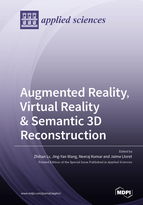Augmented Reality, Virtual Reality & Semantic 3D Reconstruction
A special issue of Applied Sciences (ISSN 2076-3417). This special issue belongs to the section "Optics and Lasers".
Deadline for manuscript submissions: closed (5 November 2020) | Viewed by 75284
Special Issue Editors
Interests: metaverse; digital twins, Internet of Things; cloud computing
Special Issues, Collections and Topics in MDPI journals
Interests: machine learning research & applications; convolutional neural networks; sparse coding; learning-to-rank
Interests: SDN; cyber physical systems; security; smart cities; deep learning; blockchain
Special Issues, Collections and Topics in MDPI journals
Interests: network protocols; network algorithms; wireless sensor networks; ad hoc networks; multimedia streaming
Special Issues, Collections and Topics in MDPI journals
Special Issue Information
Dear Colleagues,
Augmented Reality is a key technology that will facilitate a major paradigm shift in the way users interact with data and has only just recently been recognized as a viable solution for solving many critical needs. Enter augmented reality (AR) technology, which can be used to visualize data from hundreds of sensors simultaneously, overlaying relevant and actionable information over your environment through a headset. Semantic 3D reconstruction makes AR technology much promising, with much more semantic information. Although, there are several methods currently available as post-processing approaches to extract semantic information from the reconstructed 3D models, the obtained results are uncertainty, and are evenly incorrect. Thus, it is necessary to explore or develop a novel 3D reconstruction approach to automatic recover 3D geometry model and obtained semantic information in simultaneous.
The rapid advent of deep learning brought new opportunities to the filed of semantic 3D reconstruction from photo collections. Deep learning-based methods are not only able to extract semantic information but also can be used to enhance some fundamental techniques in semantic 3D reconstruction, those fundamental techniques include feature matching or tracking, stereo matching, camera pose estimation, and multi-view stereo. Moreover, deep learning techniques can be used to extract priors from photo collections, the obtained information in turn can improve the quality of 3D reconstruction.
The aim of this Special Issue is to provide a platform for researchers to share the innovative work in the filed of semantic 3D reconstruction, virtual reality, and augmented reality, including deep learning-based approaches to 3D reconstruction, and software platforms of deep learning for virtual reality and augmented reality.
This special section will focus on (but not limited to) the following topics:
- Virtual reality
- Augmented reality
- Semantic 3D reconstruction
- Color transfer in virtual reality
- Color consistency in augmented reality
- Feature detection and matching in 3D reconstruction
- Dynamic Simultaneous Localization and Mapping
- Large-scale Structure from Motion
- Augmented reality software platform
- Virtual reality hardware platform
- Applications include Cultural Heritage, Environmental recording, etc.
Dr. Jing-Yan Wang
Prof. Neeraj Kumar
Prof. Jaime Lloret Mauri
Guest Editors
Manuscript Submission Information
Manuscripts should be submitted online at www.mdpi.com by registering and logging in to this website. Once you are registered, click here to go to the submission form. Manuscripts can be submitted until the deadline. All submissions that pass pre-check are peer-reviewed. Accepted papers will be published continuously in the journal (as soon as accepted) and will be listed together on the special issue website. Research articles, review articles as well as short communications are invited. For planned papers, a title and short abstract (about 100 words) can be sent to the Editorial Office for announcement on this website.
Submitted manuscripts should not have been published previously, nor be under consideration for publication elsewhere (except conference proceedings papers). All manuscripts are thoroughly refereed through a single-blind peer-review process. A guide for authors and other relevant information for submission of manuscripts is available on the Instructions for Authors page. Applied Sciences is an international peer-reviewed open access semimonthly journal published by MDPI.
Please visit the Instructions for Authors page before submitting a manuscript. The Article Processing Charge (APC) for publication in this open access journal is 2400 CHF (Swiss Francs). Submitted papers should be well formatted and use good English. Authors may use MDPI's English editing service prior to publication or during author revisions.
Keywords
Augmented reality;
Virtual reality;
Semantic 3D reconstruction;
Color transfer in virtual reality;
Color consistency in augmented reality;
Feature detection and matching in 3D reconstruction;
Dynamic Simultaneous Localization and Mapping;
Large-scale Structure from Motion;
Augmented reality software platform;
Virtual reality hardware platform;
Applications include Cultural Heritage, Environmental recording, etc.









